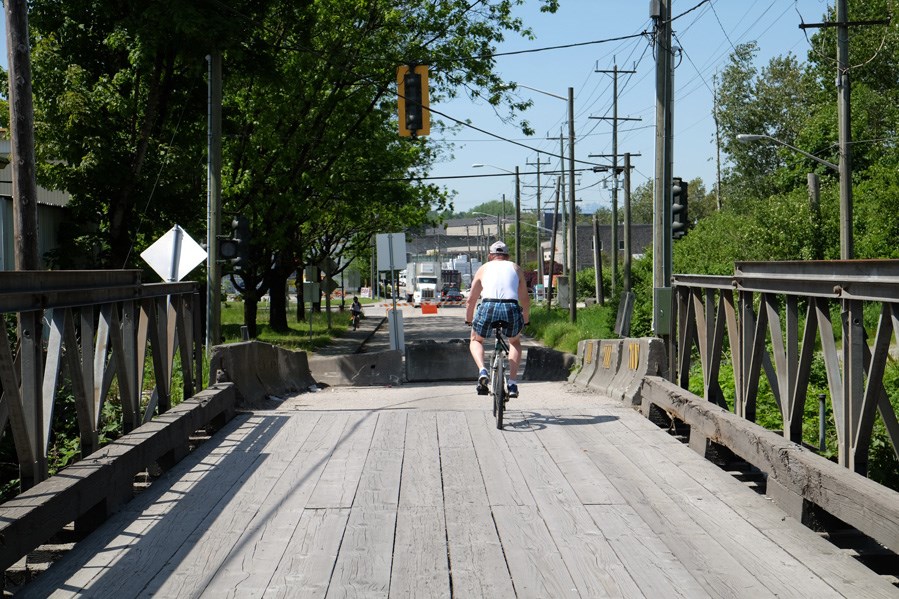A busy traffic corridor that’s been closed since March could soon reopen to traffic.
The Bailey bridge has been closed to vehicles since the beginning of March, but will off limits to all vehicles, cyclists and pedestrians starting June 30 so work can get started to install a new bridge. The city expects the new crossing to open July 23.
“The new one will be arriving this week. We will be dismantling the old one starting the week of June 30,” Jim Lowrie, the city’s director of engineering, told The Record June 23. “My understanding is it is just a few days to dismantle the old one.”
The City of New Westminster has hired Mainroad Contracting to remove the existing single-lane Bailey bridge and install the new crossing.
New Westminster is footing the entire $175,000 bill for replacing the existing Bailey bridge with a new crossing. The province had offered the city a free temporary Bailey bridge, but only if it agreed to allow a second crossing to be installed so there would be two-way traffic flow.
In related news, an arbitrator is now considering submissions from New Westminster and Coquitlam about the future of the controversial crossing. New Westminster wants a single lane Bailey bridge, while Coquitlam is pushing for two lanes.
According to Lowrie, a decision is expected by July 2. New Westminster fears that adding another lane of traffic will exacerbate traffic and safety issues in the area around Braid and Brunette.
Coun. Jonathan Cote, co-chair of the city’s master transportation committee, said he has seen New Westminster and Coquitlam’s submissions to the arbitrator.
“I am comfortable we have done the best we can to articulate the issues that we have. I have a bit of a biased opinion, but I’d say we have put forward a more comprehensive position than Coquitlam,” he said. “Once again, it’s in the arbitrator’s hand. That individual will be the one that makes the final decision.”
Arbitration is the latest move in the ongoing saga of the Bailey bridge that dates back more than a decade.
In March 2002, Coquitlam completed connection of a four-lane extension of United Boulevard west of King Edward Street to the border of New Westminster and connected this extension with Braid Street. Unimpressed that Coquitlam didn’t implement measures to prevent through-traffic from coming into the Royal City, as it had previously agreed to do, New Westminster closed a gate at the municipal boundary.
Coquitlam took the matter to court and asked that the gate be reopened.
Supreme Court Justice Bruce Cohen ruled in New Westminster’s favour, saying Coquitlam hadn’t demonstrated that any harm would come from New Westminster’s decision to prohibit through access for the general public. Coquitlam appealed and Supreme Court Justice D. Bennett ordered that New Westminster open the gate. The gate has been open since October 2002.
In 2005, Transport Canada directed the city to have traffic enforcement personnel to regulation the flow of traffic across the existing railway lines at Braid and Brunette because of safety concerns. At the time, New Westminster stated that traffic volumes across the bridge had risen from 500 in 2002 (before the four-lane extension was completed in Coquitlam) to more than 13,000 daily.
Flash forward to 2010, when the federal government was prepared to make $65 million available for the United Boulevard extension portion of the North Fraser Perimeter Road. While proponents believed there were safety and reliability benefits associated with making improvements at the single-lane Bailey Bridge and eliminating the at-grade rail and road conflicts, TransLink informed Transport Canada in 2011 that it would not be pursuing the federal funding contribution toward the project because it couldn’t find a solution that would both get the support of the City of New Westminster and meet the objectives of the Asia Pacific Gateway and Corridor Initiative.
The Bailey bridge, which was installed in the mid 1990s, was closed to traffic temporarily in February 2013 while repairs were made. In March 2014, the City of New Westminster closed the bridge permanently to after engineers found structural deficiencies.



